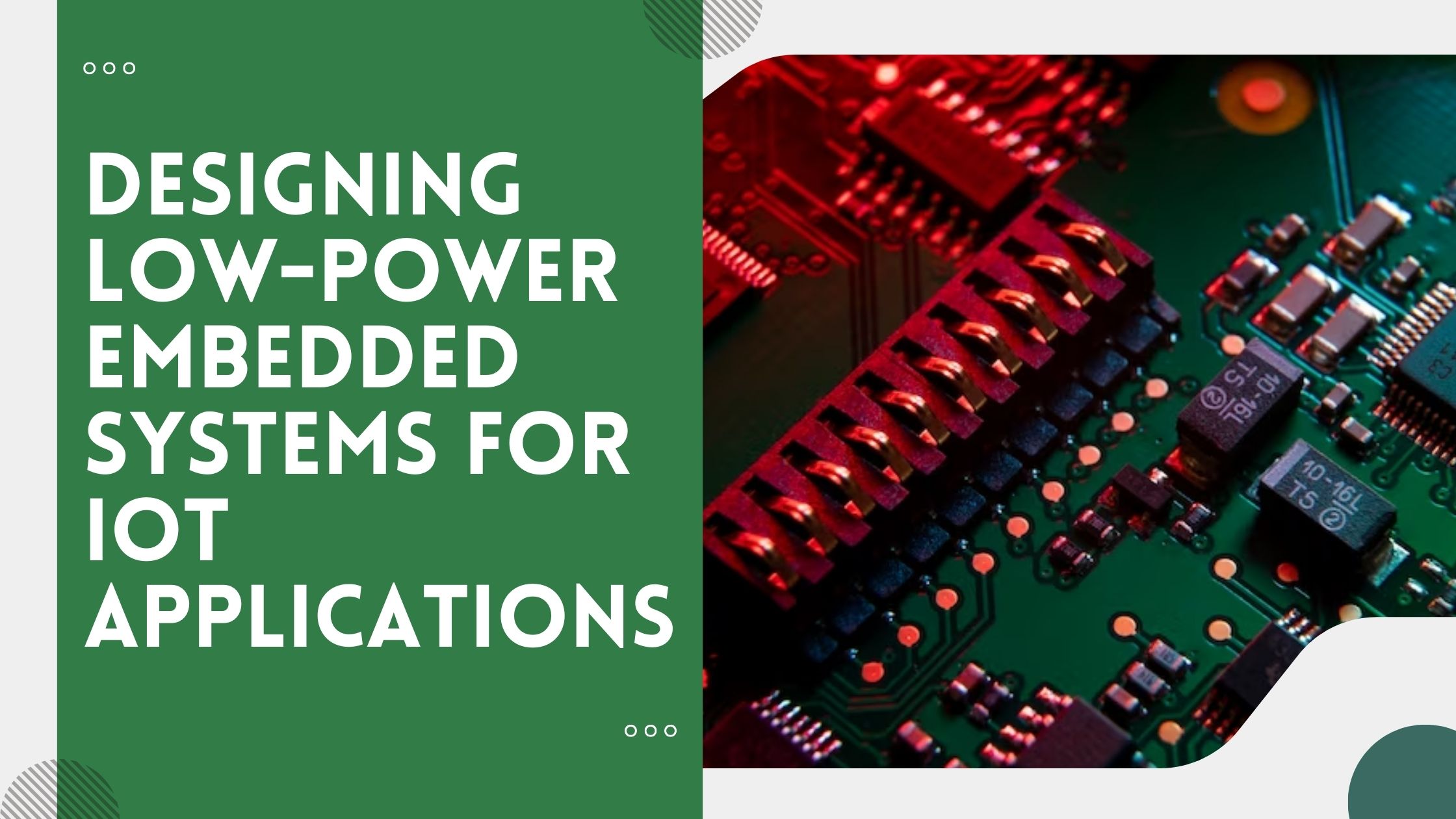Introduction
In the heart of IoT, low-power embedded systems are the unsung champions, ensuring the smooth operation of countless devices without draining the world’s energy resources. Their importance cannot be exaggerated. As our reliance on IoT grows, so does the demand for energy-efficient devices. Why? This is because these tiny powerhouses are the backbone of smart homes, smart cities, and smart industries, ensuring our gadgets work tirelessly without consuming much electricity.
Consider your smart thermostat, quietly adjusting the temperature while sipping power like a tea connoisseur savoring a fine brew. These systems enable us to monitor our health, track our assets, and control our environment seamlessly, all while minimizing the environmental footprint. As IoT continues to reshape our world, the significance of low-power embedded systems becomes increasingly clear: they hold the key to a more connected, efficient, and sustainable future.
Understanding Embedded Systems and IoT
The Internet of Things (IoT) is like a digital spiderweb, connecting everyday objects to the internet. It’s your smart fridge ordering groceries, your fitness tracker counting steps, and your car giving traffic updates. All of these are possible due to embedded systems that are working behind the scenes with tiny computer brains inside these devices. They make the magic happen.
Now, why is power efficiency so crucial in this IoT dance? Well, imagine your phone dying after a couple of hours, or your thermostat gobbling up electricity like a hungry monster. That’s where power-efficient systems step in. They ensure these devices can run for days, months, or even years on a single charge or a tiny battery. In today’s energy-conscious world, this matters immensely in saving money and reducing our carbon footprint.
In a nutshell, embedded systems and IoT are the dynamic duo making our lives smarter and more connected. Power efficiency is their secret weapon here, ensuring these smart devices keep ticking without draining our resources.
Designing Low-Power Embedded Systems
Low-power embedded development services is all about crafting smart, energy-efficient solutions that maximize device performance while minimizing power consumption. It’s like designing a car that can go the extra mile on a single gallon of fuel.
Effective design plays a pivotal role in achieving this energy efficiency. It involves making conscious choices at every stage of development, from selecting energy efficient components to optimizing software algorithms. These systems need to strike a delicate balance between functionality and power consumption, much like an athlete pacing themselves in a marathon.
Imagine a sensor in a remote wildlife monitoring station. Effective design would ensure it wakes up only when needed, collects data swiftly, and then goes back to a low-power state, conserving energy for the long haul. It’s all about making every electron count.
In essence, developing low-power systems is a blend of art and science. It’s about thinking creatively to solve complex energy challenges, resulting in devices that not only work efficiently but also contribute to a greener, more sustainable world.
Key Components of Low-Power Design
Designing energy efficient systems relies on several key components working together:
- Microcontrollers and Microprocessors: These are the brains of embedded systems. Choosing energy efficient microcontrollers or microprocessors is critical. They should have low-power modes, such as sleep or idle, and be able to quickly transition between active and low power states when needed.
- Sensors and Actuators: Sensors gather data from the environment, while actuators perform actions based on that data. Picking the right sensors and actuators help in consuming minimal power. Also, sensor fusion techniques can reduce the need for multiple sensors, resulting conserving more energy.
- Power Management Units: These units regulate the power supply to different components. They ensure that each part of the system receives just the amount of power it needs, reducing overall energy consumption. Techniques like voltage scaling and dynamic voltage and frequency scaling (DVFS) are employed to optimize power usage.
- Communication Protocols: Wireless communication consumes substantial power. Selecting low power communication protocols like Bluetooth Low Energy (BLE), Zigbee, or LoRaWAN can significantly extend battery life. These protocols use efficient data transfer methods and have low-duty cycles.
Optimizing Hardware for Low Power
Incorporating these components with a focus on power efficiency and intelligent algorithms for sleep-wake cycles is key to designing low power systems. It involves a delicate balance between functionality and energy consumption, ensuring that devices can operate for extended periods on limited power sources, making them ideal for IoT applications and remote deployments.
Optimizing hardware for less power consumption involves a variety of methods aimed at minimizing the energy usage within embedded system services. Here are some key strategies:
- Choosing the Right Components: Selecting components that are inherently energy-efficient is fundamental. This includes choosing microcontrollers, sensors, and other hardware components that have low-power variants or features. Manufacturers often provide power consumption data, making it easier to compare and choose the most energy-efficient options.
- Reducing Clock Frequencies: Lowering the clock frequency of the microcontroller or microprocessor reduces its power consumption. When the system doesn’t require high processing power, dynamically scaling down the clock frequency can be an effective way to save power without sacrificing performance.
- Using Low-Power Modes: Modern microcontrollers often offer various low-power modes that allow you to deactivate or reduce the power to unused peripherals and components. For instance, you can power down unused sensors or put the microcontroller itself in a low-power sleep mode when it’s not actively processing data. This drastically reduces power consumption during idle periods.
- Efficient Power Supplies: The choice of power supply can also impact energy efficiency. Using voltage regulators with low quiescent current and minimizing voltage conversion can help reduce power losses in the power supply circuit.
Software Optimization
Software optimization for reducing power consumption focuses on making your computer or device run more efficiently so that it uses less power. Here are some strategies:
- Efficient Coding Practices:
- Write code that is streamlined and doesn’t waste processing power.
- Minimize unnecessary calculations and loops.
- Use data structures that are efficient for the task at hand.
- Using Low-Power Libraries:
- Choose software libraries or components that are designed to be energy-efficient.
- These libraries are often optimized for low-power use and can help reduce energy consumption in your software.
- Implementing Power-Aware Algorithms:
- Design algorithms that are aware of power constraints.
- For example, you might choose algorithms that perform fewer computations or use less memory when power is limited.
- Idle State Management:
- Implement mechanisms to put parts of the software into idle or sleep states when they are not actively being used.
- For example, if a component of your software isn’t needed, it can be put into a low-power mode until it’s required again.
Conclusion
Low-power embedded systems are unsung heroes in the world of IoT. They ensure that devices operate efficiently without draining energy resources. Their significance grows as IoT’s prevalence increases, demanding energy-efficient solutions. These systems underpin smart homes, cities, and industries, enabling seamless, eco-friendly operations.
Power efficiency is paramount, as it extends battery life, saving money and reducing carbon footprints.
In summary, embedded systems are the backbone of IoT, driving efficiency and sustainability. They combine clever hardware design with efficient software to ensure devices run smoothly while conserving energy. In an increasingly interconnected world, they play a pivotal role in shaping a greener and more connected future.



